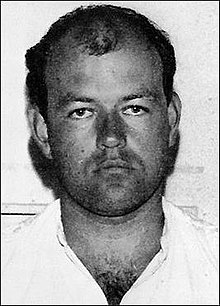| Revision as of 21:25, 31 July 2004 edit24.6.82.108 (talk) added reference to the book, since it details the story from begininng to end← Previous edit | Revision as of 21:27, 31 July 2004 edit undoDuncharris (talk | contribs)30,510 editsm spNext edit → | ||
| Line 6: | Line 6: | ||
| In 1986 Dawn Ashworth, another 15-year old, was found strangled and sexually assaulted in the same area. The ] matched that of the first attack, and semen samples revealed the same blood type. | In 1986 Dawn Ashworth, another 15-year old, was found strangled and sexually assaulted in the same area. The ] matched that of the first attack, and semen samples revealed the same blood type. | ||
| The prime suspect was local boy, Richard Buckland, who revealed knowledge of Ashworth's body, and admitted the crime under questioning, but denied the first murder. ], of the ], had recently developed ] along with ] and ] of the ] (FSS) and detailed the technique in a 1985 paper. | The prime suspect was local boy, Richard Buckland, who revealed knowledge of Ashworth's body, and admitted the crime under questioning, but denied the first murder. ], of the ], had recently developed ] along with ] and ] of the ] (FSS) and detailed the technique in a 1985 paper. | ||
| Gill commented: | Gill commented: | ||
Revision as of 21:27, 31 July 2004

Colin Pitchfork (born c. 1961) was the first person to be convicted by the process of DNA fingerprinting. Pitchfork murdered and raped two girls in Narborough, Leicestershire in 1983 and 1986 and was convicted in 1988.
In 1983, Pitchfork raped and murdered 15-year old schoolgirl Lynda Mann in the Narborough Area. Using forensic science techniques available at the time, a semen sample taken from her body was found to belong to a person with type A blood and an enzyme profile that matched only 10 per cent of males. With no other leads or evidence, the case was left open.
In 1986 Dawn Ashworth, another 15-year old, was found strangled and sexually assaulted in the same area. The modus operandi matched that of the first attack, and semen samples revealed the same blood type.
The prime suspect was local boy, Richard Buckland, who revealed knowledge of Ashworth's body, and admitted the crime under questioning, but denied the first murder. Alec Jeffreys, of the University of Leicester, had recently developed DNA profiling along with Peter Gill and Dave Werrett of the Forensic Science Service (FSS) and detailed the technique in a 1985 paper.
Gill commented:
- I was responsible for developing all of the DNA extraction techniques and demonstrating that it was possible after all to obtain DNA profiles from old stains. The biggest achievement was developing the preferential extraction method to separate sperm from vaginal cells – without this method it would have been difficult to use DNA in rape cases.
The profiles of the murderer and Buckland did not match, and Buckland became the first person to be exonerated by DNA fingerprinting.
Jeffries later said:
- I have no doubt whatsoever that he would have been found guilty had it not been for DNA evidence. That was a remarkable occurrence.
Leicestershire Police and the FSS then undertook a project where 5,000 local men were asked to volunteer blood or saliva samples. This took six months, and no matches were found.
Later however, a colleague of a man, Ian Kelly, heard him bragging that he had given his sample whilst masquerading as his friend, Colin Pitchfork. Pitchfork, a local baker was arrested and sentenced to life imprisonment for the murders in 1988. Since then, DNA fingerprinting has been used to secure many other convictions.
True crime writer Joseph Wambaugh detailed the entire story in his 1989 book, "The Blooding."